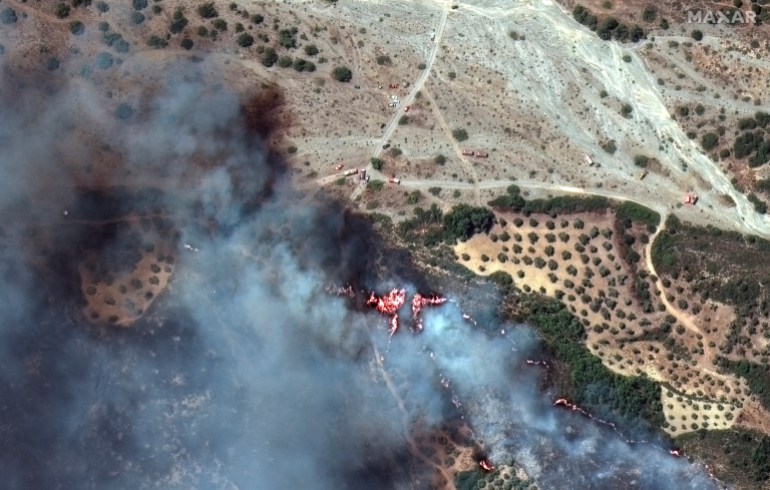July set to become world’s hottest month on record: What happened?
July 2023 has broken global temperature records, raising fears about what patterns could next emerge.

July will likely be the world’s hottest month on record and possibly the warmest in 120,000 years, according to climate scientists.
“We don’t have to wait for the end of the month to know this. Short of a mini-Ice Age over the next days, July 2023 will shatter records across the board,” UN Secretary-General Antonio Guterres said on Thursday.
Keep reading
list of 4 itemsMapping pro-Palestine college campus protests around the world
Satellite images reveal Israeli destruction of hospitals in Gaza
Mapping Israel-Lebanon cross-border attacks
It comes as heat waves sizzled large swathes of Europe, North Africa, North America and Asia.
Temperature records broken
The first three weeks of July marked the warmest period on record compared to previous averages of the first 23 days of July from 1940 to 2023.
It broke the prior record set for the full month of July in 2019 of 16.63C (61.93F) to reach 16.95C (62.51F) surface air temperature.
Temperatures in the first and third weeks also briefly rose above the 1.5C (34.7F) limit set forth in the Paris Agreement.

July 6 was the hottest day, according to ERA5 data from the Copernicus Climate Change Service with the global average temperature reaching 17.08C (62.74F).
In a joint statement the EU’s Copernicus Climate Change Service and the UN’s World Meteorological Organization (WMO) said it was “extremely likely” July 2023 would break the record.
Complete ERA5 data for July is set for publication on August 8.
Heatwaves in Europe, North America and Asia
Extreme temperatures are the result of climate change and the warming weather pattern, known as El Nino, which is responsible for a hotter-than-usual year, according to scientists.
Europe experienced some of its highest temperatures so far this summer thanks to a so-called heat dome stretching over its south.
Last year, it is estimated that there were more than 61,000 heat-related deaths during Europe’s hottest season on record.
In the US there were weather warnings of “extremely dangerous” heat in the southwest of the country.
In northwest China temperatures reached as high as 52.2C (126F), breaking the country’s record.

Wildfires in Europe
The European heatwave saw wildfires ignite across the region.
Blazes scorched hundreds of thousands of hectares of land in Greece, Italy, Portugal, Spain, France and Croatia.
According to data from the European Forest Fire Information System (EFFIS), as of July 29, the number of fires across the EU amounted to 991 – nearly double the yearly average for this time of year.
In addition, wildfires across EU countries have burned a total of 236,768 hectares (585,066 acres), 76,669 hectares (189,453 acres) more than the yearly average at this time.
While periodic wildfires benefit ecosystems by helping to clear dead organic material, the frequency and extent of recent wildfires are concerning.
Blazes have caused a number of deaths and forced large-scale evacuations.
In Greece, thousands of people were evacuated from the Greek islands of Rhodes and Corfu last week as Prime Minister Kyriakos Mitsotakis declared that the Mediterranean nation was at war with wildfires. On July 25, two pilots of a firefighting plane died after their jet crashed in Evia.

On the Italian island of Sicily, two people were found dead on July 25 in a home burned by a wildfire that temporarily shut down Palermo’s international airport, according to Italian news reports.
The destructive blazes are driven at least in part by climate change, which increases hot and dry conditions allowing fires to spread faster and burn longer.
In the Mediterranean, that has contributed to the fire season starting earlier and burning more land.
Extreme weather elsewhere
Extreme weather throughout July has caused havoc across the world, sparking forest fires, water shortages and a rise in heat-related illnesses and hospitalisations.
In North Africa, more than 30 people lost their lives in wildfires that swept through Algeria’s northern border with Tunisia.

An unprecedented wildfire season continues to rage in Canada, with a third firefighter dying trying to battle the nation’s worst wildfire season on record.
All told, more than 12.5 million hectares (30.9 million acres) have burned in Canada in 2023 so far, surpassing a previous record of approximately 7.1 million hectares (17.5 million acres) in 1995.